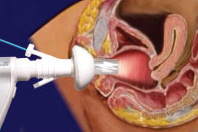
Photo from wikipedia
Study Objective To report rates and identify risk factors for urinary tract infection (UTI) following hysterectomy for benign conditions. Design Retrospective cohort study. Setting American College of Surgeons National Surgical… Click to show full abstract
Study Objective To report rates and identify risk factors for urinary tract infection (UTI) following hysterectomy for benign conditions. Design Retrospective cohort study. Setting American College of Surgeons National Surgical Quality Improvement Program (ACS NSQIP) database. Patients or Participants Women undergoing benign hysterectomy by any modality between 2010 and 2017. Interventions Abdominal hysterectomy (AH), total laparoscopic hysterectomy (TLH), laparoscopic supracervical hysterectomy, laparoscopic assisted vaginal hysterectomy (LAVH), vaginal hysterectomy (TVH). Measurements and Main Results 67,243 women included in the analysis with 1,310 postoperative UTIs identified, at a rate of 19.5 per 1000 hysterectomies. Women who developed UTIs were more likely to smoke (19.6% vs 15.7%, p= Procedures complicated by UTI were longer (148.1min +/-79.4 vs 135.5min +/-65.6, p= Following regression analysis, cystotomy (aOR=4.16, 95%CI=2.57-6.73) and TVH (aOR=2.45, 95%CI=1.99-2.99) were significant independent predictors of associated with an increased risk of post-hysterectomy UTI. Conclusion The risk of UTI after hysterectomy is low. Intraoperative cystotomy and vaginal hysterectomy are the most significant predictors of subsequent urinary tract infection.
Journal Title: Journal of Minimally Invasive Gynecology
Year Published: 2019
Link to full text (if available)
Share on Social Media: Sign Up to like & get
recommendations!